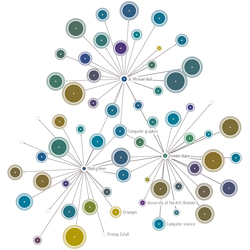 Over at Design Thinking Tim Brown (Ideo’s CEO) asked the question about the beauty of organisations. I have started to think about a similar question concerning business models so I dropped a few thoughts as comments.
Over at Design Thinking Tim Brown (Ideo’s CEO) asked the question about the beauty of organisations. I have started to think about a similar question concerning business models so I dropped a few thoughts as comments.
Still working on finding an answer on the business model question.
I really like the question of beauty and aesthetics of organizations. The major challenge with organizations is that you can not feel, touch or experience organizations. So you can not easily build prototypes or enact the service experience. And I guess organization is also related to the corresponding business model and in some cases has a legacy/history/tradition aspect that is hard to capture.
The underlying issue here is that we are lacking a agreed visual representation of organizations and business model that would allow us to use aesthetic rules to evaluate them. The closest I have come across up to now is the Business Model Canvas by Alex Osterwalder (http://www.businessmodelalchemist.com/) that allows to show business model, but still lacks aesthetic criteria.
Evaluating organizations the question is also what the final success criteria is and whether “beauty” is really translated in to innovation or business success or profitability. And is a hierarchical organization more beautiful than a small team collaborative approach. Is the 150-organization size limit at Gore beautiful ?
So I would start with looking at ways to visualize organizations and translate business models that allow aesthetic evaluation.
Hi Tim
couldn’t stop thinking about your “organizational beauty” question on top of
my previous post and here are a few more thoughts.
You take the bee colony as an example of beautiful organization and I would agree. The focus of the bees, however, is not so much on innovation but on robustness and survival. So innovation might require a specific view on organization.
Your question tries to map the abstract concept of organization to the abstract concept of beauty (and throwing in innovative-ness as a third) and I feel you probably need to put some “facts” in the mapping process.
So I would start by identifying measurable criteria/factors assumed to be relevant for innovation and organization like: team size, different areas of knowledge/competency involved in innovation process, number of
contacts required in teams, geographical distribution of teams, speed and levels of decision making within organization, innovator archetypes involved in teams, distribution of power within team (equal votes vs. few leaders).
I would then put this in some tool that could translate this for different organizations into a visual representation, e.g. using Processing and tree diagrams (see for example http://www.generative-gestaltung.de/M_6_4_01_TOOL ).
Playing around with this I guess you could already see whether there is beauty, e.g. very colorful or evenly distributed patterns in specific organizations.
Coming to the organizational archetypes for innovation you could feed organizational structures for teams which could be considered innovative/creative and look at the results, e.g. film studios/tv productions, ad agencies, research institutes, product design/development firms, startups, etc.
I would think that this could also generate some overarching principles for innovative teams, e.g. like Gore’s “not more than 150 people in one organization” or Shaker-like principles you already mentioned.
